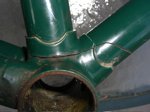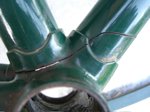The purpose of this trip, to be examined and re-examined frequently, is Paris-Brest-Paris. You’ve heard it all before, but: One of the world’s great long-distance (750 miles or so), semi-recreational, semi-masochistical cycling events: It started in 1893, a decade before the Tour de France; licensed racers are not welcome, but it’s still a ride against the clock: The longest you get to do the ride, barring extraordinary circumstances, is 90 hours; the fastest anyone has ever done it is in the neighborhood of 42 hours. This year’s ride — it’s held every four years — starts next Monday, the 20th. I’ll be starting with the biggest group of riders, leaving at 9:30 p.m. from the western suburbs of Paris with the full 90 hours to work with; that means we have to be back at the finish at 3:30 p.m. Friday. Townspeople across France call out “bonne route” and “bon courage” to hearten the riders. In advance, I’d like to say thanks, French townspeople; I’ll need all the encouragement I can get.
This here flight: Air France Flight 7. Took off from John F. Kennedy International Airport in Queens, New York at about 7:35 p.m. The flight’s supposed to take six hours and fifteen minutes. We’ve got an hour and a half to go. I’m riding in the back of a 777; I’ve got the seat in front of me shoved so far back that my laptop is sort of wedged into my abdomen. It’s a minimally ergonomic setup.
My perfect airline: Air France is OK. The cabin crew is sort of elegant, and it is not understaffed. They serve actual food, with free (and passably decent) wine, for dinner. They hand out bread rolls. But the airline is not perfect. They charged me $150 to put my bike on the plane. Four years ago when I did PBP, they just took it as my second piece of luggage and charged me nada. Or rien, to be true to the spirit of this thing. OK, so there goes a hundred and fifty bucks — oh, yeah, 300, since this is a round trip and I plan on bringing the bike back with me. That bike charge would not happen on my perfect airline.
My perfect airline, part deux: Did I tell you that the seat in front of me has been shoved so far back that I can barely move? That would not happen on my perfect airline. There’d be room enough between seats so that leaning back wouldn’t displace another passenger’s spleen. Either that, or the seats would not recline at all. Non-reclining seats would be bad news for the seat hog in front of me. You hear that, seat hog?
My perfect airline, part trois: The thrilling news is that I’m counting in French. The other news is that those little route tracker displays that have appeared on planes — mostly on international routes, I guess — have become more sophisticated. On Air France, they give you about a dozen different still and animated views of the plane’s position, along with the standard readouts on air speed and outside temperature, distance covered and time to arrival, and so on. Also, the basic maps they use are pretty much the same, with important cities like Nouakchott located (um — capital of Mauritania? I guess they speak French there). But one delightful addition to the maps of the Ocean Atlantique is the location of historic shipwrecks, complete with years they occurred — the Titanic, USS Thresher, Andrea Doria, and Bismarck have all shown up during the trip.
We’re passing south of Cork right now, the map says. An hour till we land. Forty-three below zero Fahrenheit outside, we’re at 38,000 feet, and the dawn is breaking. A baby’s squalling a few rows away, which is a bummer for its mere et pere; someone, no kidding, is calming the kid down by playing “Hey Mr. Tambourine Man” on a harmonica. That is all acceptable behavior on my perfect airline.
Technorati Tags: cycling, france, pbp, randonneuring, travel



